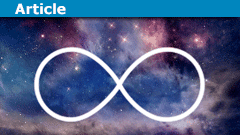Agent Smith
Full Member
- Joined
- Oct 18, 2023
- Messages
- 530
[imath]1 - 0.999... = \frac{1}{\infty} \ne 0[/imath]
0.999... is defined to be equal to 1 within the standard real number system. Hence the result derived above is incorrect.[imath]1 - 0.999... = \frac{1}{\infty} \ne 0[/imath]
It is a definition insofar as a limit is defined. The LHS makes only sense as [imath] 0.999\ldots=\displaystyle{\sum_{k=1}^\infty \frac{9}{10^k} =\lim_{n \to \infty}\sum_{k=1}^n \frac{9}{10^k}}\,.[/imath] Now, the LHS is a defined limit, a certain number. And this number equals [imath] 1 [/imath] in this case. You need a definition, namely the limit, and a proof that this limit equals [imath] 1. [/imath]I don't think 0.999... = 1 is a definition khansaheb. One assigns defs, not prove them.

I comprendo[imath] \displaystyle{L=\lim_{n \to \infty}\dfrac{1}{n}} [/imath] is a number, and that number is [imath]L= 0. [/imath] All elements [imath] 1/n [/imath] are unequal to zero. And since [imath] \infty [/imath] is not a number, we cannot pretend it is and calculate with it. Furthermore, the limit is not a process. It is a statement about a certain number, [imath] L, [/imath] the limit, and how it relates to the sequence members, also numbers.
Replacing [imath] L [/imath] in the expression may work or may not. Sure, [imath] \displaystyle{\lim_{n \to 3}\dfrac{1}{n}=\dfrac{1}{3}}, [/imath] but what will we do with [imath] \displaystyle{\lim_{n \to 2} \dfrac{n^2-4}{n-2}}\, [/imath]? The expression [imath] \dfrac{2^2-4}{2-2} [/imath] is not defined! No way, to pretend as if we could replace [imath] n [/imath] by [imath] 2. [/imath] This is only allowed if we write [imath] \displaystyle{\lim_{n \to 2}\dfrac{n^2-4}{n-2}= \lim_{n \to 2}(n+2)=2+2=4} [/imath] where we didn't use an undefined expression. The same is true for [imath] 1/n\, .[/imath] Such a thing as [imath] 1/\infty [/imath] is not defined. We cannot pretend it was.
Here is an article on why calculating with undefined expressions is not a good idea:

Why Division by Zero is a Bad Idea
A division by zero is primarily an algebraic question. The reasoning therefore follows the indirect pattern of most algebraic proofs: What if it was allowed?www.physicsforums.com
